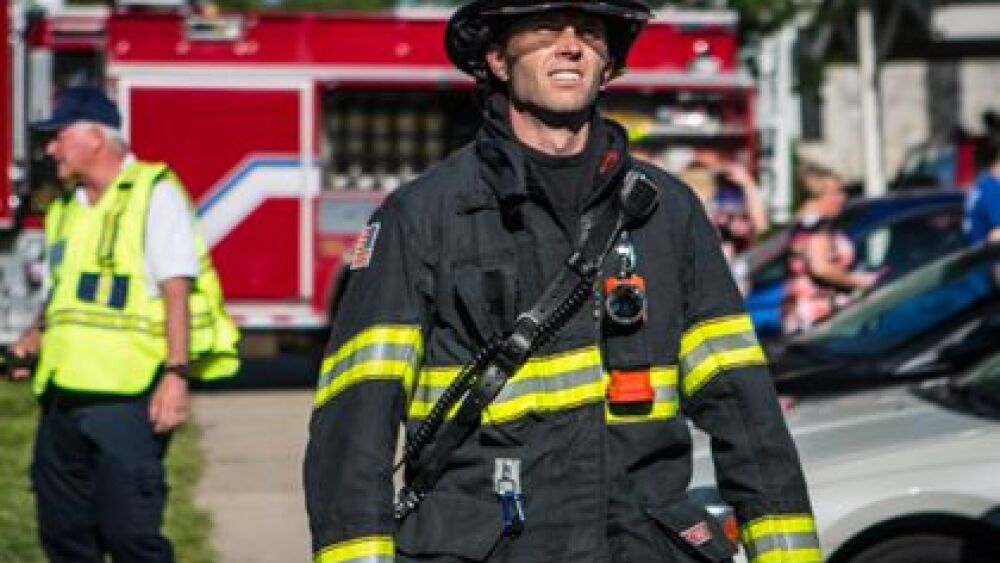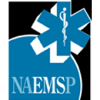This article originally appeared in the National Association of EMS Physicians blog and is reprinted here with permission.
By Lorena McConnell, MD
Edited by EMS MEd Editor James Li, MD @jamesli_17
Clinical scenario. You are part of an ALS unit that just got to the scene of a structure fire to relieve the prior unit. The firefighters have been working on fire suppression for 2 hours. You are asked to come evaluate a 38-year-old firefighter. He came out of the building 5 minutes ago and is sitting on the ground next to the structure complaining of generalized weakness and you are told his breathing seems labored. Prior to symptom onset, he was exposing hot spots behind the drywall of the structure. He is still in all of his gear; except he has his self-contained breathing apparatus (SCBA) hanging down off of his face.
This is the first time you’ve been on a fire scene, and you have a lot of questions:
-
What is the role of EMS during a fire incident?
-
What is different about the initial assessment of a firefighter?
-
What are the typical issues firefighters have?
-
What are the most life-threatening things to consider?
EMS at the Fire ground
Typical EMS operations on the fire ground are standardized by the National Fire Protection Association (NFPA). Therefore, the prior EMS unit should have already instituted what is recommended, which includes at least one BLS unit on standby and an on-scene fire rehab [1]. In some agencies, the preference is for an ALS unit to be on standby, but this is not universally required [2].
Fire rehab is an area for firefighters to rest between high-intensity activity and is used to ensure they return to duty only when medically appropriate. Fire rehab can be informal for smaller incidents, which generally entails self-directed rest and hydration, or it can be formal for larger or prolonged incidents [2]. Formal fire rehab would be indicated for the scenario above. Formal fire rehab generally consists of a climate-controlled area that is staffed by EMS personnel who are responsible for taking vitals, assessing for concerning symptoms and providing treatments (i.e. cooling, hydration, nutrition, decontamination) [2].
If firefighters do not have an improvement in vitals or symptoms, EMS personnel have the authority to keep them from returning to duty; this may include additional time in the rehab area or transport to the hospital. [3] There are strict rules on when and how often firefighters need fire rehab (i.e. use of SCBA for ≥30 minutes or 40 minutes of heavy exercise without the use of SCBA) [1,2].
Through conducting fire rehab and having a transport unit on standby, EMS can mitigate illness on the fire ground and provide care and stabilization for firefighters if illness does occur.
Scene Considerations at the Fire ground
With these resources in place, the obvious next step is to bring the patient to the fire rehab area. Arriving to the patient safely at a fire incident involves unique scene safety considerations. A typical fire ground is separated into three zones: cold, warm, and hot. The cold zone is considered relatively safe from most exposures and is where EMS and the command operations are located. The hot zone is considered the most dangerous and is where the fire apparatus and other fire suppression tools are located along with firefighters that are working the fire [2,4]. The warm zone is considered to have an intermediate risk and is a decontamination area [4].
Because of the risk levels, differing amounts of personal protective equipment (PPE) are needed to stay safe in each zone. In the hot zone, full turnout gear (boots, pants, jacket, gloves, hood, helmet and SCBA) is used. In the warm zone use of PPE ranges significantly [4]. Historically, little-to-no PPE is used in the cold zone. It should be noted that hazardous compounds above the recommended exposure limit have been detected as far out as the cold zone, even hours after the fire has been suppressed, so common PPE practices are likely to change [4].
EMS should be strategically placed in the cold zone of the incident. This means upwind from the fire, away from the heat and exposure to chemicals, out of the way of all fire apparatus, and near an unblocked roadway [2,5]. This way all patient assessments and treatments occur in a relatively safe area and rapid transport can occur if needed. The patient in the scenario above is in the hot zone and EMS is in the cold zone.
Regarding the scenario above, it wouldn’t be safe for EMS personnel to go get the patient. If the patient is unable to walk, it will be best to instruct firefighters already in full PPE to bring the patient to the fire rehab area. It would also be important for the patient to put his SCBA back on until out of the hot zone.
Decontamination
One last consideration prior to assessing the patient is decontamination. Firefighters are exposed to many dangerous compounds during fire suppression and overhaul, some of which can be immediately harmful (i.e. carbon monoxide, carbon dioxide, hydrogen sulfide, ammonia, hydrogen chloride), or harmful in the long term (i.e. carcinogens like benzene, asbestos, styrene, polycyclic aromatic hydrocarbons) [4, 5, 6]. Their turnout gear protects them from direct exposure, but these compounds can become embedded in their gear and then be absorbed through the skin by direct contact or inhaled by off-gassing [3, 7, 8].
One study showed that 25 minutes after a live fire event and doffing PPE, multiple volatile organic compounds can be measured in higher-than-normal concentrations on the fire gear and also correlated with higher-than-normal concentrations in the breath of firefighters. While the measured concentrations were below the threshold to be considered dangerous for short-term exposure, it does seem that exposure to off-gassing from PPE over prolonged periods of time or multiple times per day would be more concerning [7]. It has been shown that levels of dangerous compounds increase with each successive fire as well [9]. Gloves were found to have up to 100 times greater concentrations of dangerous compounds compared to other pieces of gear [6].
It also stands to reason that if turnout gear is not properly cleaned these chemicals can end up wherever the gear is stored, so potentially in the firehouse living spaces, bays, or vehicles [9]. Full laundering requires sending gear out, so it doesn’t typically occur after each fire call. Decontamination practices after each call vary or may not happen at all. Common turnout gear decontamination methods used include air drying in a well-ventilated area, brushing off visible soot and wiping down with soap and water. The effectiveness of reducing polycyclic aromatic hydrocarbons of each of these methods was evaluated. It was shown that soap and water worked best and were able to reduce it by 85%, a dry brush reduced it by 23%, and air drying reduced by 2% [7].
For the patient above, you may not have time for actual decontamination, but at the least, you should remove the patient’s gear and store it well away from the fire rehab to limit continued toxic exposure.
Clinical Assessment
Now that the patient is in the fire rehab area, it’s important to think about what is expected in the patient. Firefighting is considered one of the most physically challenging professions. Firefighters use heavy tools, their typical gear weighs up to 75 pounds and they are exposed to extreme heat, all while performing intense physical activity [2, 10, 11]. Turnout gear limits their mobility, making them have to work harder to move normally and impairing their balance; even the additional weight of their boots has been shown to increase oxygen demand [12,13]. SCBA adds resistance with each breath, so the high rates of ventilation that occur when fighting fires is harder to maintain [14]. SCBA has also been shown to increase the work of breathing in healthy subjects during non-fire-related exercise [15]. These downsides to their gear are in part why musculoskeletal injuries are by far the most common issue on the fire ground [9].
With all this in mind, it can be expected that tachycardia, tachypnea and fatigue are seen in the firefighter. In fire training exercises it has been shown that even most young and healthy firefighters exceed their maximum heart rate during high-intensity fire suppression activities [1, 7]. These same firefighters were found to have a sustained heart rate over 150 well into the recovery period [10].
Vital sign abnormalities don’t always correlate with symptoms, however. After reviewing fire rehab logs over a 5-year period, one study found that there was no statistically significant difference in vital signs in firefighters who had symptoms compared to firefighters without symptoms [11].
Understanding the physiologic stress that occurs makes it easier to anticipate the life-threatening illnesses that are possible. Heart attacks and overexertion are unfortunately common because of these physical demands [16]. Sudden cardiac death can also occur. It was shown that one-third of young and healthy firefighters had transient pathologic ST changes on EKG during a fire training exercise [10]. If this occurs in healthy firefighters, it seems logical that older people who already have an element of heart disease would be at risk for the same, or potentially more severe EKG changes.
Since we can expect to see abnormal signs and symptoms after fire suppression activities, the evolution of their illness becomes much more important. Luckily most firefighters’ vital sign changes and symptoms resolve after typical fire rehab, but if things worsen or change there would be cause for concern [11].
Lastly, keep in mind that if not properly protected with SCBA or other respirators, inhalation of any number of hazardous fumes, from simple irritants like ammonia, or asphyxiants like carbon monoxide, may occur. The fire ground can be a dangerous place, so take all symptoms seriously.
For the patient above, it will be important to get initial vitals and do a thorough neurologic exam and allow for a period of cooling and hydration. At this point, if the exam or vitals are concerning, care for the firefighter like any other patient and transport to the hospital.
Highlights
-
EMS main role on a fire scene is to keep firefighters safe; generally this is done through fire rehab. This may include telling them they aren’t safe to return to duty or transporting them to the hospital. Keep in mind that overexertion, stress, and medical issues accounted for 55% of on-duty firefighter deaths in 2020 [16].
-
Nowhere is truly safe from harmful exposures on the fire ground. Take care of yourself and others by requiring full PPE in the hot zone and encouraging half-face mask respirators in warm and cold zones for extra precaution.
-
Proper decontamination of turnout gear can help in the short term against continued off-gassing of harmful chemicals and it can help in the long term against prolonged exposure to carcinogens.
-
Turnout gear is a blessing and a curse; it allows firefighters to work for longer periods of time in hazardous environments, but it also causes more physiologic stress.
-
Can’t-miss diagnoses include heart attack and inhalation of asphyxiants. Look out for neurologic symptoms, chest pain or shortness of breath. When in doubt, transport to the hospital is warranted.
Read more
How to rehab firefighters in extreme heat, cold
Rehab is difficult and doubly so when the temperatures soar or plunge; here’s a look at how to handle those challenging days














